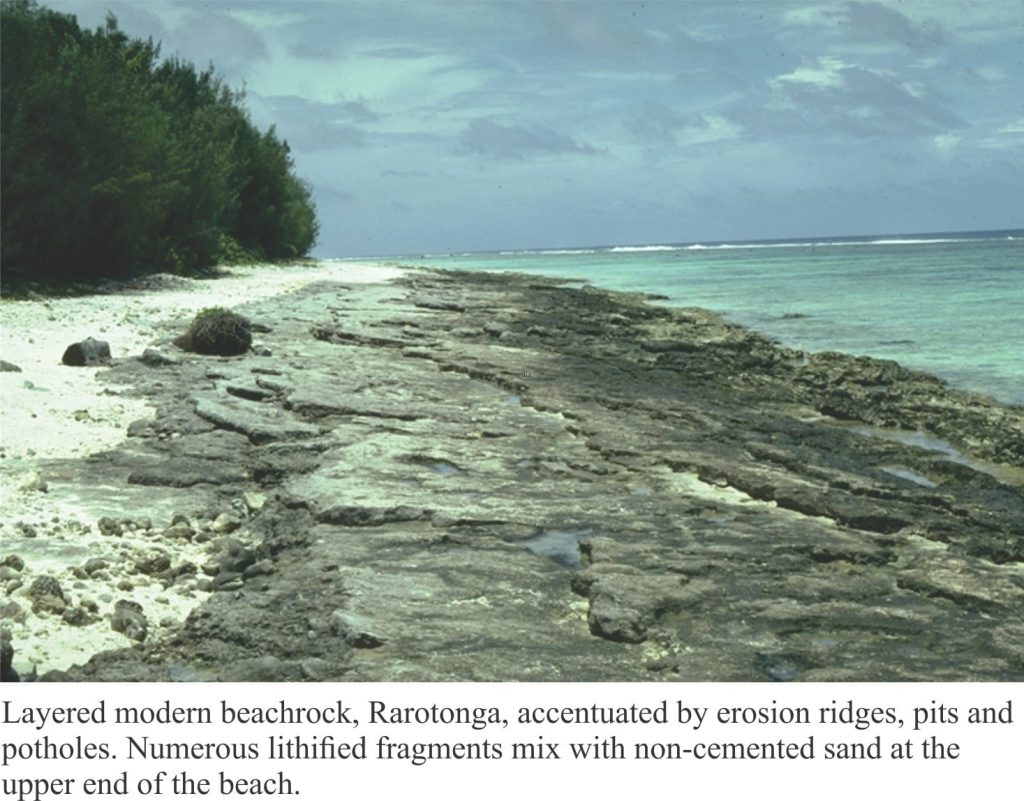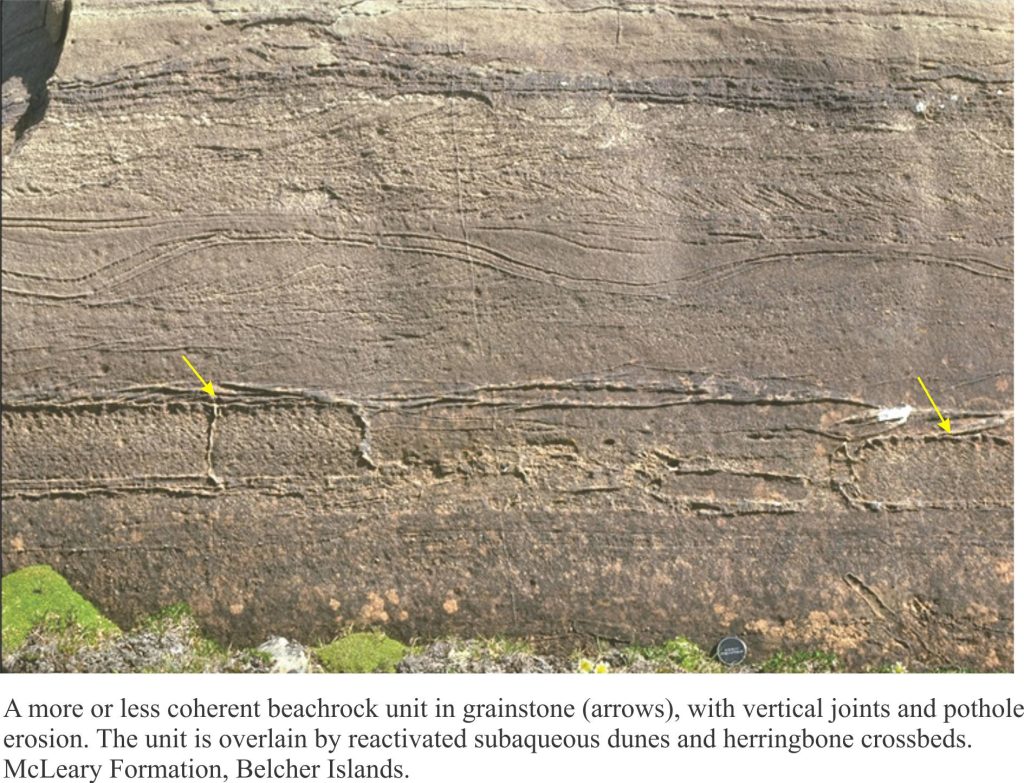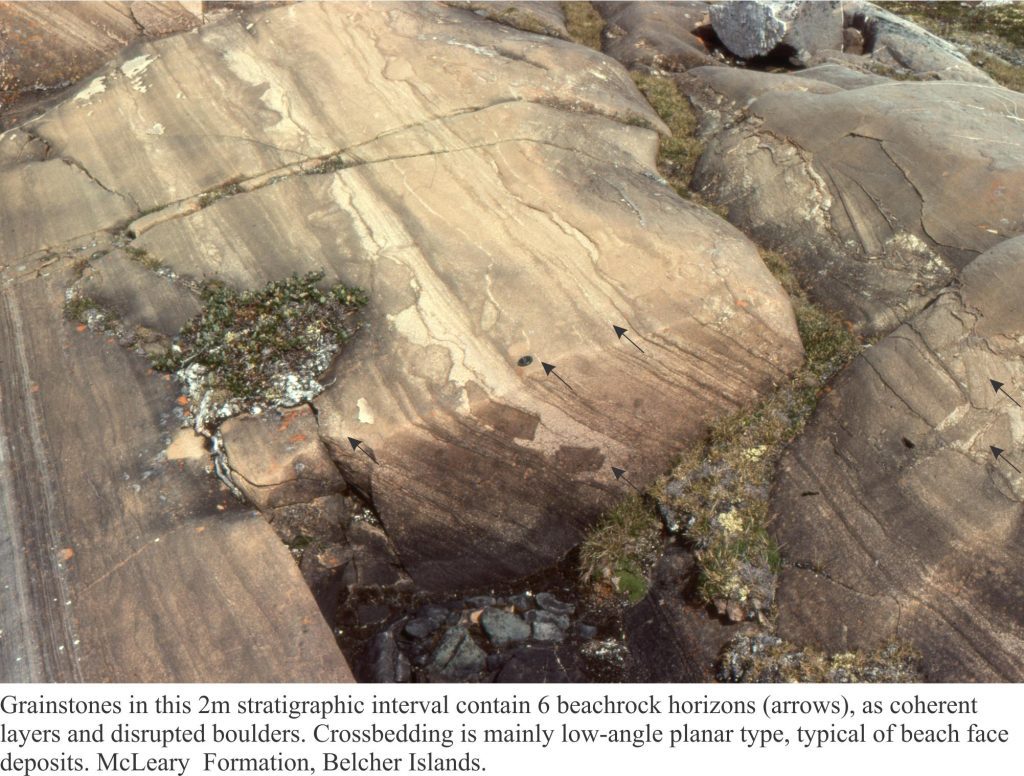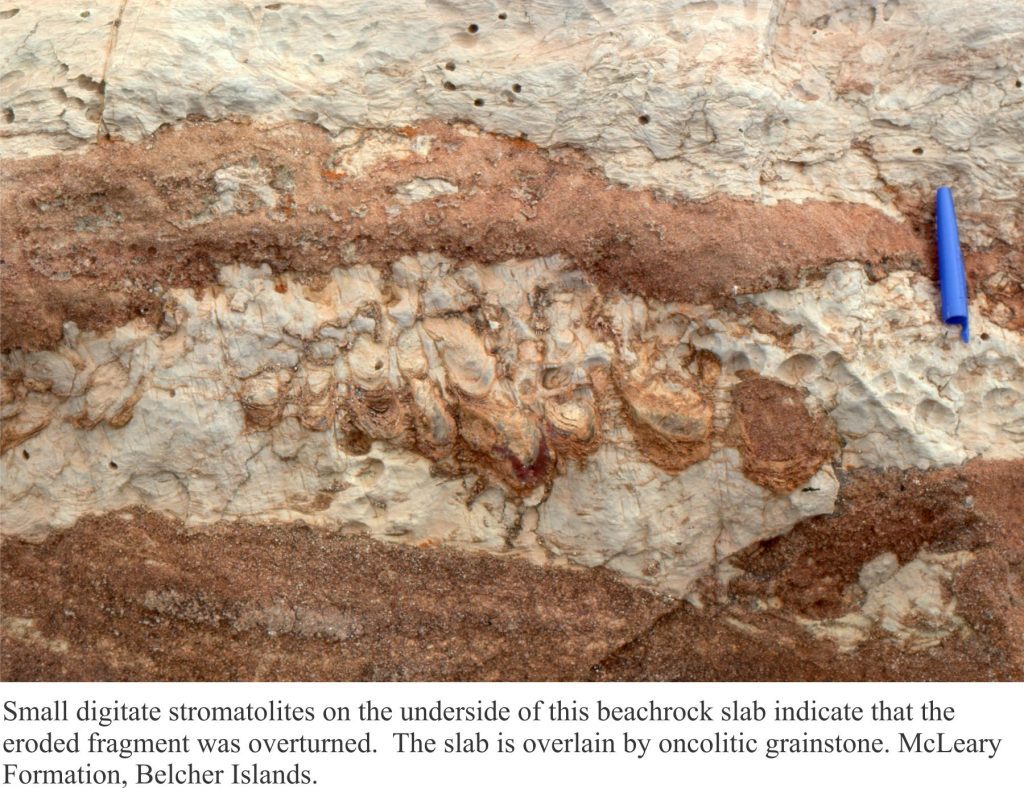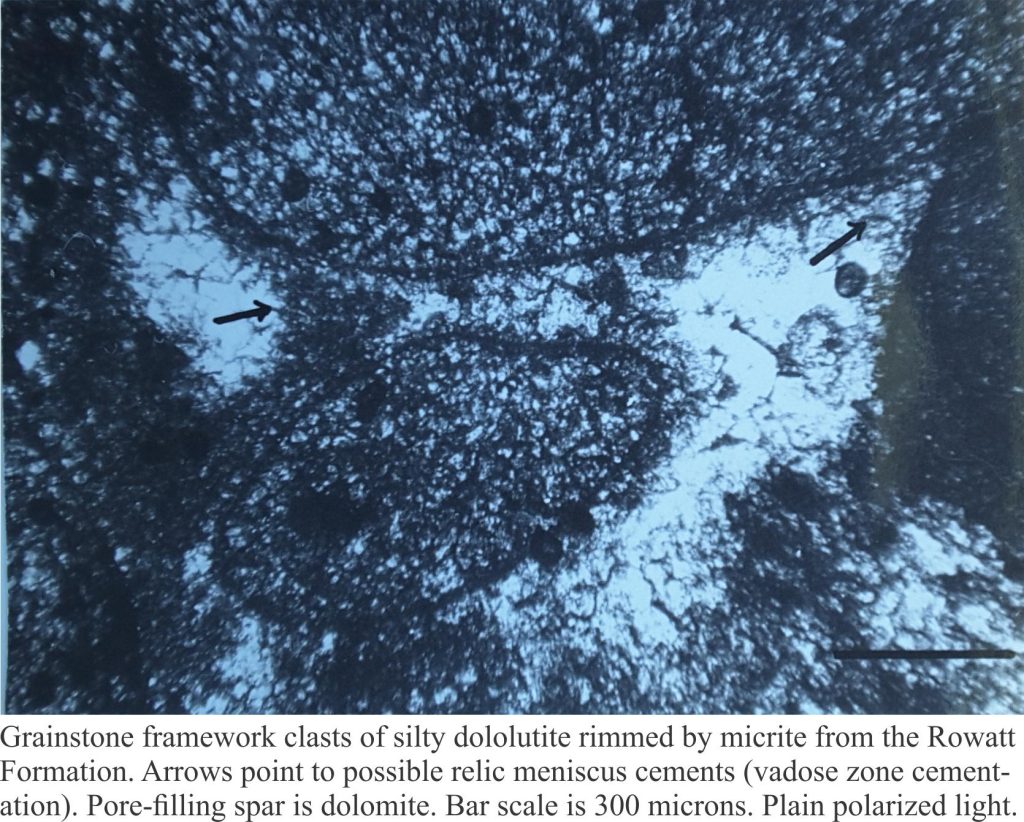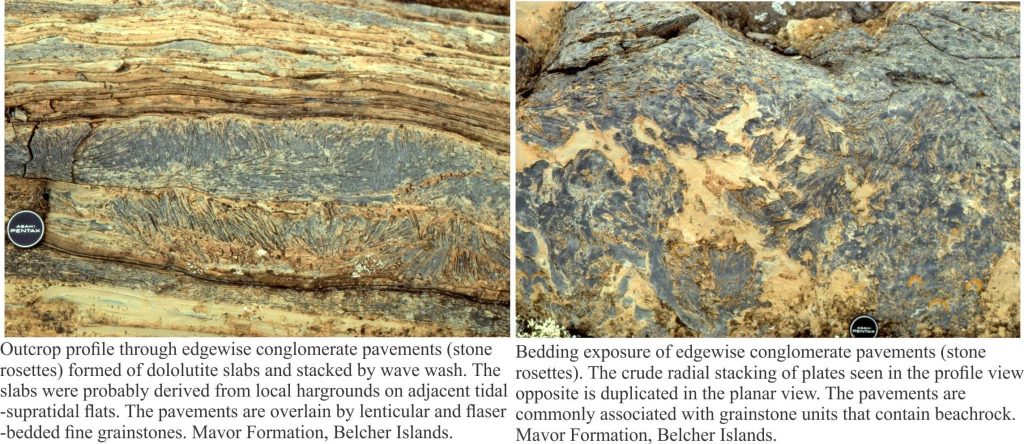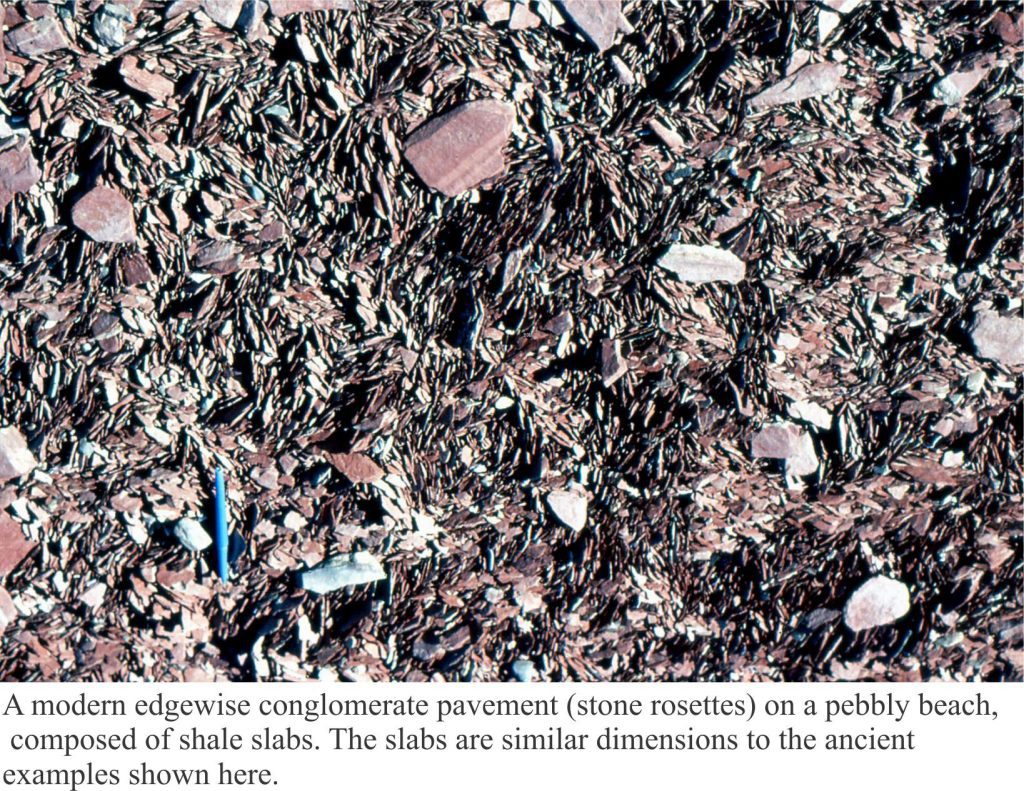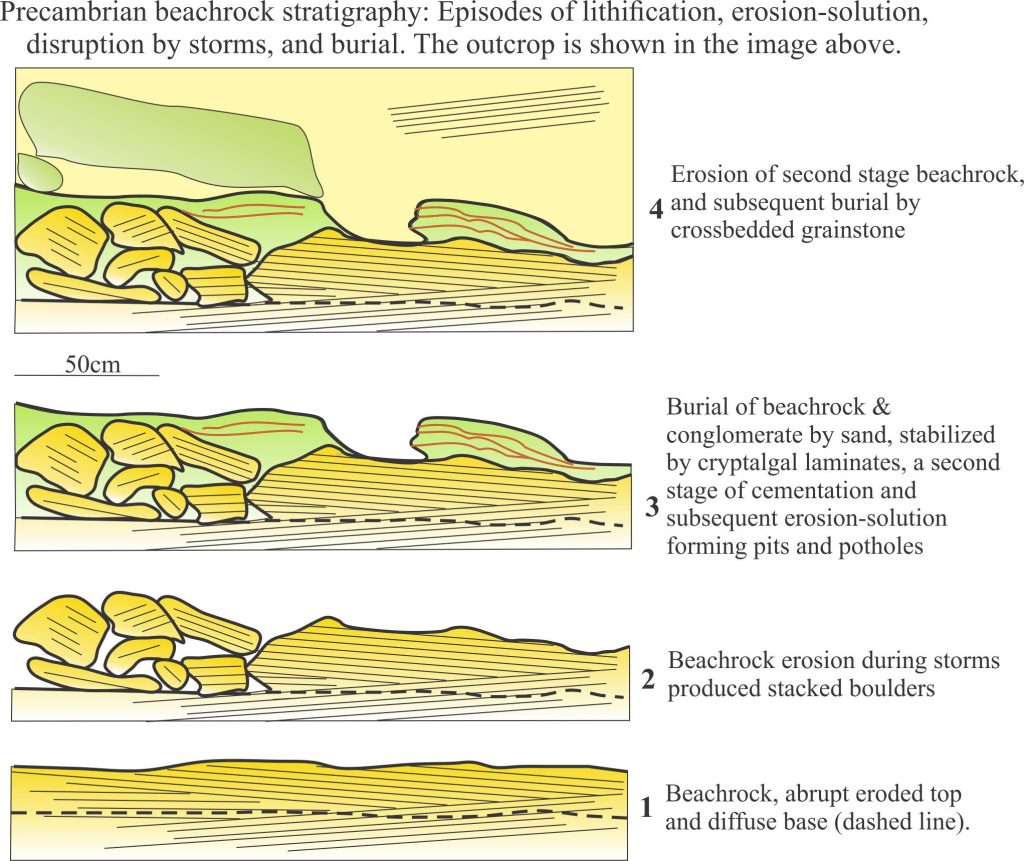Early lithification of beach sand. This is part of the How To…series on carbonate rocks
One of the most recognizable products of seafloor cementation is beachrock; lithified beach sand. Modern beachrock is common on tropical coasts, those that are wave-washed and quieter shores sheltered by reefs and island barriers. It is less likely to be found bordering cooler seas. Beachrock forms in clean carbonate and siliciclastic-volcaniclastic sands. Lithification occurs so rapidly (months, years) that one can find all sorts of interesting relics entombed – shells, fish skeletons, coconuts, the flotsam and jetsam of wars, boats that have come to grief, or the refuse strewn by centuries of ocean travelers.
Beachrock affords a domicile for algae and invertebrates that would not normally enjoy living on a soft sand beach; thus, its formation may change existing biotas. It also provides a protective carapace to a beach, reducing the impact of waves. Formation of beachrock potentially changes the beach dynamics.
Ancient beachrock is an excellent indicator of past sea levels and to some extent paleoclimates.
Several mechanisms for the formation of beachrock have been proposed; debate remains about the relative importance of these mechanisms (for explanations check out the texts linked at the end of the article):
- Direct precipitation from supersaturated sea water,
- Pumping by waves and tides that successively raise and lower CO2 partial pressures in the beach sand.
- The direct involvement or mediation of precipitation by algae and other microbes.
Reports of fossil beachrock are few, despite the likelihood of it having been a common constituent of ancient beaches. In part this is because beachrock and beach sand compositions are identical. Unless there is clear evidence for preferential lithification then its presence in the rock record might easily be missed.
The diagnostic criteria for identifying beachrock in the rock record are illustrated here with an example from the 2.0 – 1.8 billion year-old Belcher Group (Hudson Bay). This story was published in 1979 but it is a fitting opportunity to resurrect it here.
Three lines of evidence should be considered when identifying fossil beachrock: macroscopic evidence for preferential lithification, microscopic evidence for early cements, and associated sedimentary facies that indicate contemporaneous inter- supratidal environments.
Outcrop characteristics
- The starting material is clean sand that is essentially cohesionless.
- Cemented layers can form on the beach surface or just below it. Upper boundaries are typically abrupt; lower boundaries tend to be diffuse, reflecting the downward expansion of a cementation front.
- Upper boundaries that are exposed may contain erosion and solution pits, depressions, potholes and undercutting, similar to omission surfaces.
- Crossbedding will be truncated at upper boundaries and continuous through lower boundaries.
- Beachrock is commonly jointed; subvertical joints may be enlarged by erosion and filled with smaller bits of beachrock and sand.
- Jointed and eroded sandstone layers that grade laterally into non-disrupted sandstone of the same composition.
- Erosion, particularly by storm surges will dislodge blocks that are overturned or stacked into flat-boulder conglomerate that may be involved in a subsequent stage of lithification.
- Cryptalgal laminates may coat any of the exposed surfaces. In some cases, small digitate stromatolites may grow. The laminates will be prone to the kind of erosion and disruption that the host rock is exposed to.
- In Phanerozoic examples, lithification provides a home for a diverse intertidal biota including Pholads (a group of bivalves that bore into hard substrates) and other types of molluscs, calcareous algae, barnacles and bryozoans.
Cement characteristics
- The beach environment is part of the marine vadose zone. Common cements include micrite rims, meniscus cements, isopachous fringes and radial clusters of acicular crystals.
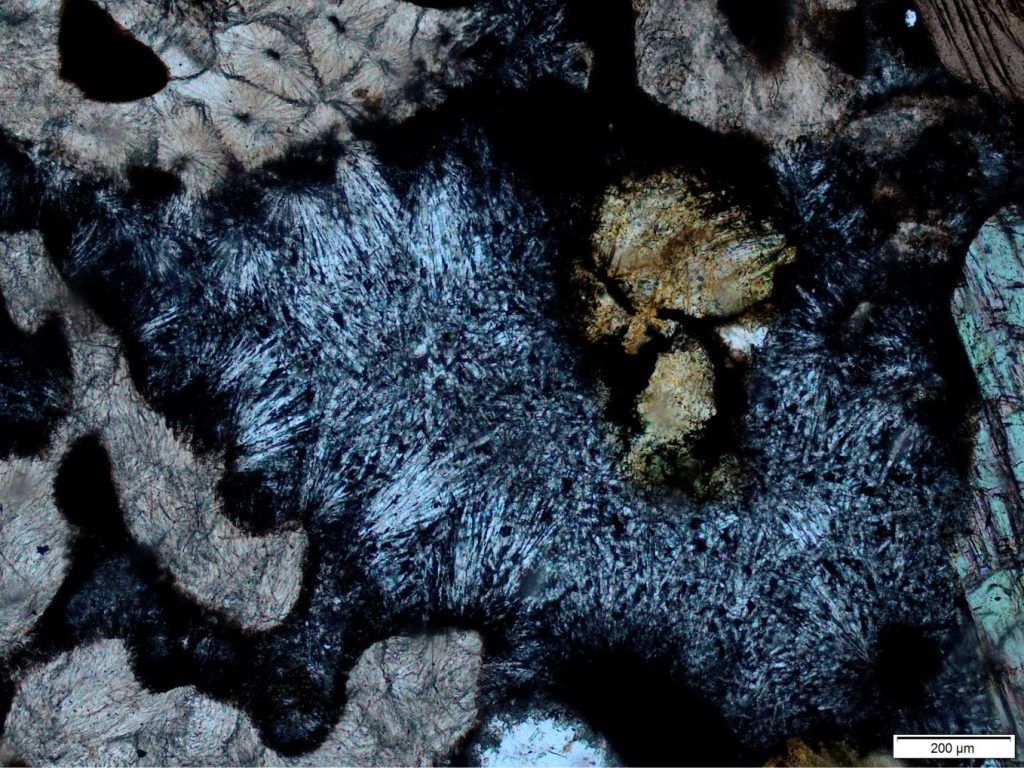

Radial aragonite clusters cementing scleractinian coral fragments (top and bottom left) and hornblende crystals (far right), in modern New Caledonia beachrock. PPL
- Fibrous aragonite or high-Mg calcite cements are the norm in modern tropical-subtropical climes. Cementation is less common in cooler waters, precipitating mainly as low-Mg calcite. These early cements will recrystallize as low-Mg calcite during burial or exposure to meteoric conditions. Any changes to these early cements will depend on changes in relative sea level; regression potentially exposes the rock to seaward migrating meteoric conditions and replacement of the metastable phases by low-Mg calcite and drusy calcite, transgression may expose the beachrock to phreatic sea floor diagenesis. In the Belcher examples all these cements have been replaced by dolomite.
- Recrystallization and neomorphism during meteoric or burial diagenesis may destroy original cement fabrics, rendering them indistinguishable from other diagenetic environments.
Associated facies
- Key to this set of criteria is evidence of tidal current reversals and periodic exposure. Common bedforms include interference ripples, reactivation surfaces, true herringbone crossbeds, flaser and lenticular bedding. Paleocurrent measurements will confirm the presence of tidal reversals.
- Periodic exposure is indicated by mudcracks, and in sabkha-like settings, gypsum and halite (in the rock record these may be casts or pseudomorphs).
- Edgewise conglomerates, also called stone rosettes, form on modern wave-washed beaches where there is a plentiful supply of platy rock fragments or shells. They form pavements where clasts are organized in crude radial or aligned patterns. In the examples illustrated here, the platy clasts were dololutite slabs about 5mm thick with flat surfaces up to 300mm wide; they are interpreted to have been derived from local mud hardgrounds. In some cases, they were stacked against beachrock boulders.
- Formation of cryptalgal oncolites is not indicative of tides but they most commonly form in high energy conditions where they are rolled across the sea floor.
- Teepee structures formed by evaporite crystal expansion and hardground deformation are common in sabkhas. The McCleary Formation contains good examples of these structures.
- In the Precambrian, cryptalgal laminates are a feature of carbonate platforms. Cryptalgal structures commonly grade from simple mats in intertidal-supratidal zones to more complex geometries (digitate, columnar, domal) in shallow subtidal areas. These transitions should be recognizable in shallowing or deepening upward cycles.
The examples shown here are from the McLeary and Rowatt formations (Belcher Islands), the exposure of which allows almost continuous stratigraphic and lateral examination. Both units accumulated on carbonate platforms. Units containing beachrock are associated with tidal flat and supratidal facies that bear abundant evidence of tidal currents and frequent exposure. In the Belcher examples, prolonged exposure in supratidal environments is evidenced by gypsum, and less commonly halite pseudomorphs.
A key identifier of synsedimentary lithification is the presence of flat, stacked and overturned grainstone boulders that can be traced laterally to relatively undisturbed layers. Most of the observed beachrock layers also contain enlarged joints, potholes, and solution pits. Beachrock in the McLeary Formation is commonly associated with cryptalgal laminates that bound the original sand, but also draped the rough, eroded surface of lithified layers. Multiple episodes of beachrock lithification are indicated where dislodged blocks are overlain by grainstone that, in turn became jointed and eroded.
Links to other posts in this series:
Mineralogy of carbonates; skeletal grains
Mineralogy of carbonates; non-skeletal grains
Mineralogy of carbonates; lime mud
Mineralogy of carbonates; classification
Mineralogy of carbonates; carbonate factories
Mineralogy of carbonates; basic geochemistry
Mineralogy of carbonates; cements
Mineralogy of carbonates; diagenetic settings
Mineralogy of carbonates; seafloor diagenesis
Mineralogy of carbonates; meteoric hydrogeology
Mineralogy of carbonates; Karst
Mineralogy of carbonates; Sabkhas
References:
J.A. Donaldson and B.D. Ricketts, 1979. Beachrock in Proterozoic dolostone of the Belcher Islands, Northwest Territories, Canada. Journal of Sedimentary Research (1979) 49 (4): 1287-1294.
B. D. Rlcketts and , J. A. Donaldson, 1979. Stone rosettes as indicators of ancient shorelines: examples from the Precambrian Belcher Group, Northwest Territories. Canadian Journal of Earth Sciences, 1979, v. 16: 1887-1891.
A couple of recent reviews:
D. Kelletat. 2006. Beachrock as Sea-Level Indicator? Remarks from a Geomorphological Point of View. Journal of Coastal Research, Vol. 22, pp. 1558-1564
M.I. Vousdoukas, A.F. Velegrakis, and T.A. Ploaritis. 2007. Beachrock occurrence, characteristics, formation mechanisms, and impacts. Earth-Science Reviews 85(1-2):23-46 – Open Access
You will also find excellent summaries in:
Robin G.C. Bathurst, 1976. Carbonate Sediments and their Diagenesis. Elsevier, Developments in Sedimentology, 12. 658p. An example of the longevity and utility of one of the best on this topic. Now also as an ebook.
Noel James and Brian Jones. 2015. The origin of carbonate sedimentary rocks. American Geophysical Union, Wiley works, 464p.An excellent recent update.
Erik Flugel. 2010. Microfacies of carbonate rocks: Analysis, interpretation and application. Springer. The ebook is cheaper

